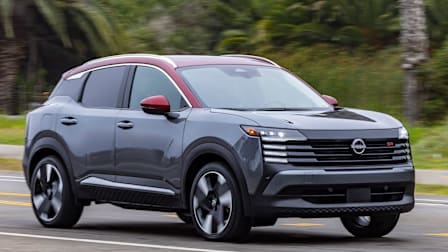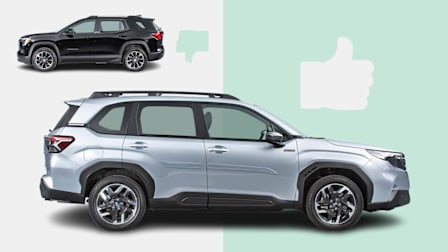What You Can Do to Find a Good Used Car Now
High prices, older cars, and high interest rates make used-car buying difficult—and expensive

Shopping for a used car right now can be particularly daunting, with a shortage of newer, low-mileage inventory, high interest rates, and high prices all standing between buyers and their next car. With tariffs now raising prices and electric vehicle tax credits being discontinued, some new-car shoppers may consider a used car to save cash, adding competition for those desirable late-model vehicles.
The average price of a 3-year-old used car has risen to over $30,000 for the first time since 2023 amid a perfect storm of market pressures, Edmunds reports. Fewer cars were made and leased during the pandemic, which has translated into fewer lower-mileage, late-model leased vehicles making it back to dealership lots today. Edmunds’ own for-sale listings reflect that, with the average age of used cars on its website increasing from 5.7 years in March 2024 to 6.1 years in March 2025.
Other Ways to Make the Best of the Current Used-Car Market
Consider buying a new car. A new car may be more budget-friendly than you think, especially if you’re looking at a late-model used car. According to Edmunds, the difference in average transaction prices between a new vehicle and a 3-year-old used one has narrowed to just $16,970. If you’re looking at a 1- or 2-year-old used car, that difference can be even smaller. Available manufacturer and dealership incentives can help knock that difference down even further. Holidays like Labor Day that fall toward the end of the year often come with some of the sharpest deals because dealers want to move slower-selling inventory off the lots to make room for next year’s models. And with new cars, there’s also the added benefit of a fresh factory warranty.
If you have to borrow money to buy a car, remember that the older the car, the higher the interest rate charged by the lender. Per Experian, the average interest rate on a new-car loan is 6.73 percent, nearly half of the 11.87 percent average rate for used-car loans. New-car buyers with good credit may also be eligible for the manufacturer-subsidized financing offered with some brand-new models. Some manufacturers are still offering 0 percent financing deals, especially on less popular models and EVs that are about to lose eligibility for federal tax credits.
Which models come with incentives and promotions can change from week to week, so look at manufacturer and dealership websites to find out whether there are any current ones on the models that interest you, and check the pricing tab on CR’s car model pages to see what local buyers have paid for the model.
Look at older models. You won’t be alone in driving an older car. The average vehicle on U.S. roads is now 12.8 years old, according to the automotive industry analysis firm S&P Global Mobility. The same depreciation that shaves thousands of dollars off the price of new cars continues through a car’s life, making opting for an older vehicle an easy way to save cash.
If you decide to buy an older car, Consumer Reports recommends looking at models known for reliability. Vehicles more than 5 or 6 years old aren’t likely to be covered by a factory warranty anymore (although many EVs have 10-year battery and powertrain warranties). You can purchase an extended warranty or service plan, but it’s usually better to set money aside for possible use on future repairs instead. The downside is that if you have to finance the purchase, interest rates tend to be higher on loans for older cars, but at least you will have less to finance.
Best Used SUVs, Sedans, Small Cars, and Minivans of 2025
These top models—all tested by CR’s experts—should suit all budgets.
Shop used EVs—preferably before Sept. 30. Buyers looking for all the modern bells and whistles at a truly cut-rate price should consider an EV. Electric vehicles face the steepest depreciation of any type of vehicle, losing an average of nearly 59 percent of their initial value over five years, a recent iSeeCars study found. EV production outpaced demand in the past few years, so even used models that are still covered under factory warranties are often priced to sell. But our experts say that great prices can often signal reliability concerns or other issues. Always look at reliability and other key data before committing to a purchase.
Tax credits and other incentives can make EVs an even better deal. Buyers can save up to $4,000 on EVs priced under $25,000 through a federal tax credit, but this will be discontinued on Sept. 30, 2025. Other state and local incentives for purchasing a used EV may still be available even after the federal tax credit goes away, so it’s always worth checking with your local authorities or your power company to see if there’s more money to be saved.
Prearrange financing. Figure out your budget and get financing based on what you can afford to pay monthly and as a down payment. It’s always a good idea to secure financing through your bank or credit union before going to a dealership to look at cars. That way, you have a baseline you can compare with dealer financing offers, which may or may not be as good a deal.
As always, setting up financing for a private-party sale is a little more difficult. You’ll need to have the funds secured and ready to pay out so that you can buy a car quickly if you find one that’s reliable, fuel-efficient, and meets your other needs.
Cast a wide net. Prices outside your area may be better. You can find a good variety of used models on websites like TrueCar, operated by a CR partner, and through Consumer Reports’ Used Car Marketplace. Expand your geographic search if you need to. Be cautious about searching too far from home, though. You want to be able to go see any car you’re considering buying and test-drive it before signing a sales or leasing contract. This is especially true for used cars. And you don’t want the car to get scooped up while you’re traveling to see it.
Do your research. Whether buying new or used, consult Consumer Reports’ road tests and ratings, looking closely at reliability, owner satisfaction, and safety. Make a short list of contenders to test-drive, and have a good understanding of the various trim versions and available features. Print out information on the models you’re interested in from CR.org and manufacturer websites to take along with you.
Buy something reliable. If you can’t find a newer used car within your price range (including financing), you may find yourself looking at older models that you wouldn’t otherwise have considered. CR recommends taking any used car to a reputable mechanic to have it inspected before buying it. (If the owner or dealer balks at this request, you may be better off looking elsewhere.) You can also consult CR’s predicted reliability scores to make sure you buy something that’s not likely to give you problems later.
Be willing to compromise. If you have to buy an older car, some of the features you want—whether those are advanced safety and driver assistance features or connectivity—might not be available. Decide which are absolute must-haves, and be flexible on the rest. Do prioritize safety, comfort, efficiency, and reliability, because satisfaction with those may mean you’ll be happy to keep the car longer. As always, you’re more likely to find deals among less sought-after models like small sedans and front-wheel-drive SUVs, while larger SUVs and pickups tend to sell more quickly despite being more expensive.
Don’t borrow too much. Put as much money into a down payment as you can afford. This is good advice in any economic climate. Maximizing your down payment will reduce the amount you have to pay in interest on the rest and minimize the chance that you’ll be left hanging with more debt than equity as your aging car’s value sinks over the years.
For example, if you have to borrow $15,000 for a used SUV that will be worth less than $10,000 in a year or two, you may end up “underwater,” or owing more than the car is worth, especially with the average interest rate on a used-car loan at roughly 12 percent. If you crash the car or if it’s stolen, you’ll still have to make payments, even though you no longer have the car.




















